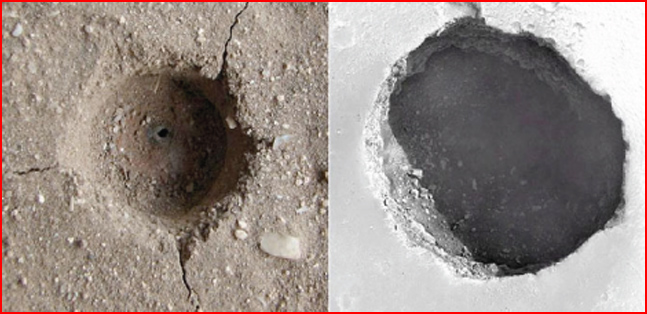
home •
about •
essential guide •
picture of the day •
thunderblogs •
news •
multimedia •
predictions •
products •
get involved •
contact
picture of the day archive subject index
Left: 3mm crater electrically etched in caliche. Credit: C. J. Ransom, VEMASAT Labs.
Right: 150 meter Martian "skylight." Original image credit: NASA/JPL/University of Arizona
Jun 19, 2008
Martian Skylights in the LaboratoryDeep cylindrical pits on Mars are not easy to explain. Small-scale plasma discharge experiments could offer some clues to their formation.
In previous Thunderbolts Picture of the Day articles about unusual geological structures on Mars, we have included craters, canyons, dunes and many other features that do not readily correspond to contemporary theories about their evolution. Dunes that do not align with the direction of the prevailing winds and that do not show any movement after years of observation are odd. Other anomalies include crater rims with steep vertical walls and kilometer-deep canyons with no outflow channels.
On the slopes of Olympus Mons, often mistakenly called the largest volcano in the solar system, are several large holes that seem to be excavated vertically for hundreds of meters. On Earth some volcanoes have similar "pit craters" on their flanks. They have no connection to fumaroles or lava chambers so they are thought to be from gas pockets that collapsed, leaving sinkholes behind. However, with the recent awareness that plasma activity is involved with volcanic eruptions on Earth it should also be considered when dealing with Mars.
The same activity may have occurred there, but if so, it must have been billions of years ago when the last volcanic eruptions took place there. If the "skylights" are that old, surely they would not look like they were dug into the surface a short time ago.
As we have written elsewhere, Olympus Mons has all the characteristics of a lightning blister, or fulgamite, but on an incredible scale. If small blisters have been found on spark arrestors after a lightning strike on Earth, one can imagine the size of the burst that hit Mars and formed the Tharsis Montes volcanoes - Olympus Mons in particular. The giant mound is covered with raised dendritic ridges flowing down its sides like hardened Lichtenberg figures. The caldera chiseled out of its summit is unlike the volcanic vents found anywhere on Earth - the same dendritic ridges outlining its foundation are also molded into those cliff faces.
In the image at the top of the page, an enhanced Martian skylight is compared to a crater blasted into caliche by Dr. C. J. Ransom's electrical apparatus. A one-second spark from the discharge terminal drilled into the stone, forming a crater almost identical to the large version from Mars. The cracks, the helical path downward into both craters, the "rubble" on the bottom and the hemispherical nips taken out of both rims are quite evident.
Craters and pits such as these vary enormously but they all possess the distinguishing features of electrical arc machining. An arc will usually  contact the surface at a 90-degree angle and typically will consist of one or more discharge channels that rotate around an empty center. If the electric arc remains stationary for a period, it will carve out a circular crater. Most of the surface material will be lifted away and the edge will have a sharp rim. If the current passing through the surface varies, the depth and diameter of the crater may vary, causing terraces to be cut into the walls.
All of those characteristics can be seen in both "pit craters" - C. J. Ransom's laboratory example and the example from Mars. Perhaps the other examples on Earth should be evaluated differently?
By Stephen Smith
__________________________________________________________________________Please visit our new "Thunderblog" page
Through the initiative of managing editor Dave Smith, weve begun the launch of a new
page called Thunderblog. Timely presentations of fact and opinion, with emphasis on
new discoveries and the explanatory power of the Electric Universe."The Electric Sky and The Electric Universe available now!

|
|

|
EXECUTIVE EDITORS:
David Talbott, Wallace Thornhill
MANAGING EDITORS:
Steve Smith, Mel Acheson
CONTRIBUTING EDITORS: Michael Armstrong, Dwardu Cardona,
Ev Cochrane,
C.J. Ransom, Don Scott, Rens van der Sluijs, Ian Tresman
WEBMASTER: Brian Talbott
Copyright 2008: thunderbolts.info
![]()
home
thunderblogs
forum
picture of the day
resources
team
updates
contact us

